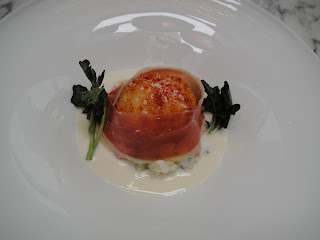Recently I came across the nifty downloadable Approach Guide series of cultural travel guides created by husband-and-wife team Jennifer and David Raezer. The concise guides are available for the iPad, iPhone, Kindle, Nook or in PDF format. They are highly specialized, either focused an aspect of a country's art or culture (wooden temples of China and Japan, for example) or on its food and wine. Recently Jennifer sent me the latest issue, AG's Guide to Sushi and Sake in Tokyo.
It's basic stuff that seasoned Japan travelers will not need, but invaluable for the first-time or novice visitor. Tips range from how to order and eat sushi at a restaurant (dip the fish side, not the rice side, of a piece of nigiri sushi into soy sauce) to alcohol pouring etiquette (pour for others, not yourself). Even for seasoned Japan travelers, the glossaries on the different types of sushi and sake are helpful.
This guide is $2.99, and prices for other guides in the series go as high as $7.99. The most popular cultural guide, says Jennifer, is the New York City Cast Iron Architecture of SoHo and Tribeca guide, and for food and wine, the AG Italian Wine Guide.
Intrigued by the idea of the Approach Guides, I asked Jennifer a few questions about the series:
For our food and wine guides, our goals are threefold: (a) help travelers quickly identify key regional dishes and wines to try in each place; (b) give helpful local tips on eating and drinking that will make fitting in a little easier; and (c) provide a framework that provides a foundational understanding of how things work so that travelers will be prepared for any situation (for example, for Sushi and Sake in Tokyo, we do not profile individual sake producers, but rather the prevailing styles and what makes each style unique).
It's basic stuff that seasoned Japan travelers will not need, but invaluable for the first-time or novice visitor. Tips range from how to order and eat sushi at a restaurant (dip the fish side, not the rice side, of a piece of nigiri sushi into soy sauce) to alcohol pouring etiquette (pour for others, not yourself). Even for seasoned Japan travelers, the glossaries on the different types of sushi and sake are helpful.
This guide is $2.99, and prices for other guides in the series go as high as $7.99. The most popular cultural guide, says Jennifer, is the New York City Cast Iron Architecture of SoHo and Tribeca guide, and for food and wine, the AG Italian Wine Guide.
Intrigued by the idea of the Approach Guides, I asked Jennifer a few questions about the series:
What gave you and your husband the idea for these clever guides?
In 2004, we decided to take a career break (5 years!) to travel. When we started out upon our adventure, we did not plan on creating a guidebook series, however, we found that most guidebooks did not offer the depth of information on cultural sites that we were seeking. So we decided to create what we wanted ourselves: guidebooks that help you go deeper and connect with the world around you through art, architecture, history, food, and wine. One of the most unique aspects of our guidebooks is that we help travelers (who necessarily have limited time in one place) determine what is special about each site and draw connections among other sites.
For our food and wine guides, our goals are threefold: (a) help travelers quickly identify key regional dishes and wines to try in each place; (b) give helpful local tips on eating and drinking that will make fitting in a little easier; and (c) provide a framework that provides a foundational understanding of how things work so that travelers will be prepared for any situation (for example, for Sushi and Sake in Tokyo, we do not profile individual sake producers, but rather the prevailing styles and what makes each style unique).
Who does all the research and how do you go about conducting it?
David and I currently are the sole authors for Approach Guides and the initial series (37 guidebooks) is based on our first-hand travel experiences; we accumulated a large portion of the background information from which we have crafted these guidebooks during the years we spent traveling. The process is this for each destination: we plan our itinerary based around a theme, research each site we plan to visit in advance, and then travel to each site where we take photos and make our own observations. We then synthesize all that we have read and experienced in order to create unique content for each guidebook.
How do you pick your guide topics?
The topics are chosen based on those things in which we have a strong interest. If we don't believe that
something will deliver a compelling travel experience, we won't write about it.
something will deliver a compelling travel experience, we won't write about it.
What did you and your husband do before launching this venture, or what do you continue to do in addition to launching this venture?
Our backgrounds make the perfect combination to launch Approach Guides. David worked in finance as an equity researcher for Morgan Stanley and I have always worked in marketing and business development for internet companies. In addition to the ebooks, we also have a series of wine apps for the iPhone and iPad, so we definitely keep ourselves busy!
What is your ultimate goal with the Approach Guides?
Our goal is to give travelers information that will help them explore, experience, discover, and connect with their destination through its art, architecture, history, food, and wine. If we do it right, travelers will use our guides to go deeper and understand more about how each destination fits into a broader context. Once they have the basics down, they are empowered to make their own discoveries...and this, for us, is the reason to travel.








